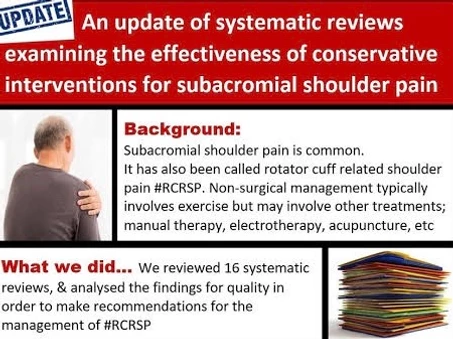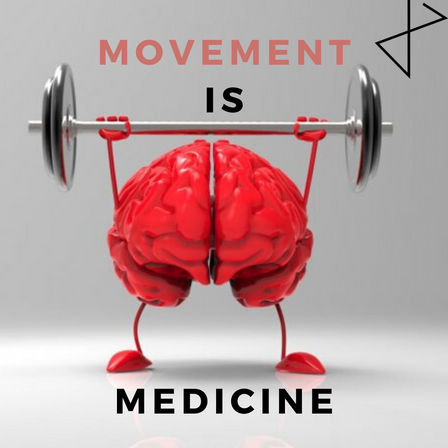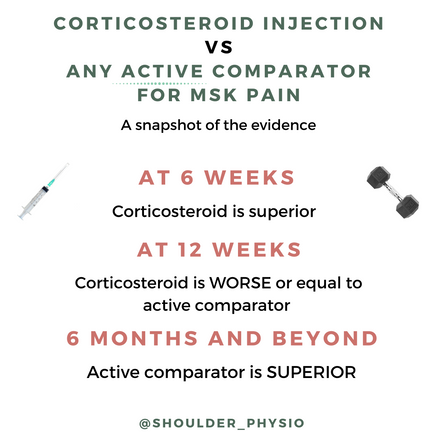How do we treat rotator cuff pain (without the knife!)?
Jan 09, 2020
In this BLOG post I am reviewing an article By Louise Pieters, featuring co-authors Jeremy Lewis and Filip Struyf (two of my favourite shoulder researchers). The paper is featured in the JOSPT.

Background
The basic intent of this article was to review systematic reviews of CONSERVATIVE INTERVENTIONS in the management of subacromial shoulder pain (SSP) (can be used interchangeably with rotator cuff related shoulder pain and subacromial impingement).
In 2013, Chris Littlewood and his group published a similar review and reported exercise and multimodal physiotherapy was effective in the management of SSP BUT to what extent wasn't clear (ref).
This review aimed to analyse the literature in the last 6 years and determine recommendations for the non-operative management of SSP.
A REVIEW OF SYSTEMATIC REVIEWS IS FAIRLY STRONG EVIDENCE!
Methodology
The date range for data collection was set from September 2012 - September 2018.
Study selection included SYSTEMATIC REVIEWS that included RCTs involving people with signs and symptoms suggestive of SSP.
Systematic reviews had to evaluate the effectiveness of non-surgical and non-pharmacological treatments, including:
- Exercise
- Exercise + manual therapy
- Multimodal physiotherapy (exercise, manual therapy, taping, modalities, corticosteroids, needling)
- Corticosteroid injection
- Modalities
16 relevant studies were eventually deemed appropriate to analyse.
Results
The outcome of this systematic review produced 5 recommendations about the management of SSP:
- Strong recommendation for exercise therapy to manage subacromial shoulder pain
- Strong recommendation for exercise therapy + manual therapy (big result!)
- Weak recommendation for multimodal physiotherapy
- Moderate recommendation for corticosteroid injection
- No evidence for laser, ultrasound, shockwave, and pulsed electromagnetic energy (surprise, surprise)

1. Exercise therapy
Multiple studies published over the past 6 years reveal a strong mechanism of effect for exercise therapy. There is HIGH quality evidence that supervised and home based strengthening exercises for the rotator cuff and scapula muscles are effective in the management of SSP, in both the short (<1 month) and long term (>3 months) (ref).
There is evidence that scapula focused approaches to shoulder strengthening could confer benefit over generalised approaches in the short term (up to 6 weeks), but this effect is lost beyond 6 weeks (ref). There is no evidence that scapula focused interventions can change/normalise scapula kinematics. This finding is an area of interest to me, and leads me to invoke my favourite quote from Jo Gibson;
"The rotator cuff and the scapula are like Gin and Tonic, don't separate them!"
Essentially, most "scapula" exercises are just good shoulder strengthening exercises that load the rotator cuff in equal doses. It's time we stop with this dichotomous view of the shoulder being scapula focused or rotator cuff focused, it all matters!
There is strong evidence that exercise therapy should be the first line intervention for SSP to improve pain, ROM and function (ref).
There is evidence that exercise therapy is superior to non-exercise based interventions and that specific exercise is superior to general exercise (low-moderate evidence).
The outcome of this review is clear, exercise therapy IS EFFECTIVE in the Mx of SSP. What remains obscure is the nuances of exercise prescription? For example; is concentric superior to eccentric or vice versa? Is open kinetic chain superior to closed kinetic chain? Do we go to fatigue or not? How much pain is allowed? There is still a long way to go to ascertain answers to these questions, if, in fact, they're answerable! The optimal regime for one person is probably entirely different for another person. I look more at relevance and accessibility when prescribing exercise to people with SSP. From here, I then reverse engineer an appropriate regime they're motivated to perform consistently.
2. Manual therapy
The strong recommendation for manual therapy in addition to exercise therapy may surprise some members of the MSK world. One systematic review found that exercise therapy + manual therapy was superior to exercise alone for pain and function but only at short term follow-ups (ref). Another systematic review reported adding manual therapy to an exercise program may be effective for pain but it is unclear whether it can improve function (ref). Desmueles et al 2015 reported no significant difference when adding manual therapy to an exercise program (ref).
The type of manual therapy performed in this review is heterogeneous and could include mobilisations, soft tissue therapy, passive stretching etc. etc. It is impossible to recommend a particular form of manual therapy that should be applied to the shoulder complex to manage SSP. However, given manual therapy may improve pain and occasionally function IN THE SHORT TERM, the authors suggest a strong recommendation to include manual therapy in addition to exercise therapy for the conservative management of SSP. This seems a touch optimistic to me; I would prefer a moderate recommendation, and I think pragmatically the evidence supports this viewpoint.
3. Multimodal physiotherapy
The definition of multimodal physiotherapy in this review was: non-surgical management including; passive modalities, exercise, manual therapy, taping, corticosteroids or electrotherapy.
The very nature of this definition will make it near impossible to achieve a measurable effect for multimodal physiotherapy. There is simply too much going on.
The results of this study echoed this sentiment. There is low-quality evidence that multimodal physiotherapy is effective in the management of SSP. This is not to say these interventions are ineffective, more that when combined in an ad hoc way it is hard to detect a measurable positive effect. What I take from this is an exercise with the addition of manual therapy (maybe) is superior to doing everything you can think of to help someone with SSP. Focus on education, a couple of exercises, and maybe a quick and effective manual therapy technique.
4. Corticosteroid injection
The concept of injection therapy for subacromial shoulder pain warrants an entire literature review on its own. The suggestion of this review is, essentially, corticosteroid injection may offer a short term benefit in pain and function compared to physical therapy. At longer follow-ups, this effect is not only lost but often worse. This reminds me of a recent social media post I created, see the image below.
The recommendation of this review is a moderate recommendation for corticosteroid injection in the management of SSP. Most studies pointed to an injection being a SECOND LINE treatment after failure to respond to exercise therapy. I think this is a sound interpretation of the literature.
Disclaimer: this review does not delve into the probable adverse effects of a corticosteroid injection on rotator cuff tendon health. This concept is arguably the most important reason to use cortisone sparingly.

Modalities
I will keep this section quite brief:
-
STRONG recommendation can be made not to use laser therapy in the treatment of SSP (ref, ref)
-
There is no evidence for the effectiveness of of therapeutic ultrasound (ref)
-
Evidence does not support the effectiveness of shock wave therapy (ref)
-
Strong recommendation that there is no evidence supporting the effectiveness of pulsed electromagnetic energy for SSP (ref)
This confirms my bias neatly and I hope we can put to rest this approach to the Mx of any MSK condition.
Final thoughts
There is strong evidence for the effectiveness of exercise therapy in the management of subacromial shoulder pain. This strengthens the position of Littewood et al 2013. Exercise should be the first line of treatment for SSP. As physical therapists, this is a green light to advocate exercise to our GP and surgeon colleagues and I suggest we be proactive about this. Questions remain, however, about whether there is an optimal type or dose of exercise. I am unconvinced we will answer these questions any time soon.
Interestingly, there was a strong recommendation to add manual therapy to an exercise therapy regime. Again, the type, intensity, frequency, and duration of manual therapy is not known, but, may not matter. I have already written up a literature review on this topic (see here). I see it like this; manual therapy may facilitate short term pain relief and may be of benefit in addition to an exercise regime. It probably does not improve function and it should not be a stand alone intervention. If using it, be careful to frame it in the appropriate context.
Corticosteroid injections may be utilised when progress using exercise therapy has plateaued. Multimodal physiotherapy including taping etc. is not more effective than exercise therapy. There is no evidence for modalities.
In closing, your role as an MSK clinician is to get people moving in a progressive and therapeutic manner. This job description is strongly evidence based. Everything else should serve to maximise this philosophy.
Thanks for reading :)
The Complete Clinician
Tired of continuing education that treats clinicians like children who can’t think for themselves?
The Complete Clinician was built for those who want more.
It’s not another lecture library, it’s a problem-solving community for MSK professionals who want to reason better, think deeper, and translate evidence into practice.
Weekly research reviews, monthly PhD-level lectures, daily discussion, and structured learning modules to sharpen your clinical edge.
Join the clinicians who refuse to be average.


